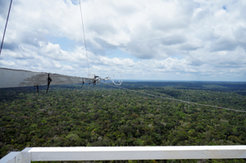Record growth in atmospheric CO2, in spite of stable anthropogenic emissions, due to weaker sinks

The high growth in atmospheric CO2 was mainly caused by a smaller uptake of carbon in the terrestrial biosphere in response to warm and dry conditions over tropical land. These unusual conditions were caused by the recent El Niño event that lasted from May 2015 to June 2016. In 2015, the land sink was smaller than usual at 7 [4 to 10] Gt CO2 per year, only 60% of its average intensity during the previous decade.
“What we see here is the response of land ecosystems to large interannual climate variability”, explains Dr. Sönke Zaehle from the Max Planck Institute for Biogeochemistry in Jena, Germany, who contributed model simulations to the study. He continues, “on average, the land biosphere takes up carbon and slows the growth rate of atmospheric CO2, and will probably continue to do so for the next years. However, years like 2015 with a strong El Niño event should remind us that climatic swings with warmer temperatures and more drought have a strong effect on the land carbon storage.”
The high in the atmospheric growth rate occurred despite the fact that global carbon emissions did not increase much any more for the third year in a row. CO2 emissions from fossil fuels and industry did not grow in 2015 (at 36.3 Gt C per year), with world-average emissions per person at 4.9 t CO2 per year. Professor Corinne Le Quéré, Director of the Tyndall Centre at University of East Anglia, UK, who led the data analysis, said: “This third year of almost no growth in emissions is unprecedented at a time of strong economic growth, and it is possible that the trajectory of global emissions has permanently deviated from the long-term growth trend.”
Verification of reported emissions cannot yet be done with independent data because of uncertainties in our capacity to account for carbon fluxes in the natural environment. The implication is that, at the moment, it could take 5-10 years before a peak in global CO2 emissions is confirmed with independent data.
Publication:
Global Carbon Budget 2016
Le Quéré, C., Andrew, R. M., Canadell, J. G., Sitch, S., Korsbakken, J. I., Peters, G. P., Manning, A. C., Boden, T. A., Tans, P. P., Houghton, R. A., Keeling, R. F., Alin, S., Andrews, O. D., Anthoni, P., Barbero, L., Bopp, L., Chevallier, F., Chini, L. P., Ciais, P., Currie, K., Delire, C., Doney, S. C., Friedlingstein, P., Gkritzalis, T., Harris, I., Hauck, J., Haverd, V., Hoppema, M., Klein Goldewijk, K., Jain, A. K., Kato, E., Körtzinger, A., Landschützer, P., Lefèvre, N., Lenton, A., Lienert, S., Lombardozzi, D., Melton, J. R., Metzl, N., Millero, F., Monteiro, P. M. S., Munro, D. R., Nabel, J. E. M. S., Nakaoka, S., O’Brien, K., Olsen, A., Omar, A. M., Ono, T., Pierrot, D., Poulter, B., Rödenbeck, C., Salisbury, J., Schuster, U., Schwinger, J., Séférian, R., Skjelvan, I., Stocker, B. D., Sutton, A. J., Takahashi, T., Tian, H., Tilbrook, B., van der Laan-Luijkx, I. T., van der Werf, G. R., Viovy, N., Walker, A. P., Wiltshire, A. J., and Zaehle, S.
Earth Syst. Sci. Data, 8, 605-649, doi:10.5194/essd-8-605-2016, 2016.
http://www.earth-syst-sci-data.net/8/605/2016/
This media release is part of the Global Carbon Budget 2016, the annual update by the Global Carbon Project. It is based on the analyses published here:
-Le Quéré et al. (2016) Global Carbon Budget 2016. Earth System Science Data
Access:
- Data and figures
- Data interface for exploring data
- Prior to embargo: ESSD paper and Infographics can be requested for media purposes to press@uea.ac.uk
- After embargo: ESSD paper is open access available at link above
Social media:
- Infographic address
Funding:
- Contributors to the Global Carbon Budget 2016 are funded by research organisations and government departments in multiple countries and supported by their organisations.
- The Global Carbon Atlas that provides easy access to the emissions data is funded by the BNP Paribas Foundation
- A full list of funders is provided in Table B1 of the ESSD paper
Contact:
Dr. Sönke Zaehle
Dpt. Biogeochemical Integration
MPI for Biogeochemistry
07745 Jena, Germany
Phone: +49 (0)3641-576230
Email: szaehle@bgc-jena.mpg.de
